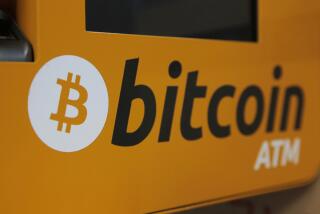Automated Tellers
- Share via
A recent California court case may have a dramatic impact on access to ATMs by people with disabilities.
Earlier this year, a California appeals court reversed a lower court ruling and said banks have a statutory duty under state civil rights laws to provide access to ATMs for such people. The case had been brought against a Sacramento bank by a man in a wheelchair who said stairs to an ATM blocked his access.
The California Bankers Assn. has been working with state officials for some time in an attempt to come up with standards for access to the machines. But the bankers feel that the issue was clouded by the appeals court ruling because it left unclear the degree of access that must be provided, such as whether special access must be provided to one machine at a financial institution or to all of them, said Maurine C. Padden, legislative counsel for the bankers group.
Whatever the outcome, banks expect to spend a considerable amount of money redesigning installations to make the machines more accessible.
Since 1979, Bank of America’s ATMs have dispensed more than $36 billion in cash--enough $20 bills to reach around the Equator seven times.
B of A has more ATMs than any other bank in the country; it opened its 1,500th in April in Del Mar. Since 1979, Bank of America customers have conducted more than 975 million ATM transactions, and the bank now processes almost seven such transactions a second.
Diebold Inc. of Canton, Ohio, dominates the market for ATM manufacturers in the United States with a 46% share, according to Spencer Nilson, publisher of the Santa Monica-based Nilson Report. Next are NCR at 20% and IBM at 19%.
Two domestic makers discontinued production last year, and two Japanese firms are trying to break into the market. Japan’s Fujitsu has a 2% share of the U.S. market and Omron, another Japanese firm, has 1%.
Nilson says he does not expect the market shares to change much in the United States in the coming years. Worldwide, NCR is the leader, followed by Diebold and IBM.
An ATM can cost between $10,000 and $40,000, depending on the sophistication of the machine and the manufacturer.
Diebold’s $10,000 model simply dispenses cash. For $35,000 or so, a buyer gets an ATM capable of multiple functions, such as accepting deposits, issuing a written balance statement, transferring money between accounts and paying bills. The more expensive machines are the biggest sellers.
Banks are increasingly trying to recover their costs and generate income by charging fees for ATM transactions. Nilson says the average is now about 50 cents, but he expects most transactions to cost $1 before too long.
Manufacturers may have made their ATMs too well.
Shipments of new machines have remained flat in recent years. Manufacturers had expected replacements to take up the slack and make up 50% of the market by now. But that has not happened.
Users have found that the machines do not seem to wear out as fast as had been expected. The average life of a machine has gone to 10 years from 7 1/2.
Last year, replacements accounted for about 35% of ATM installations, according to an article this month in Bank Administration, an industry publication.
Banks and ATM networks are paranoid about security.
They do not want to talk about how much cash their machines hold, and no institution will allow a photograph to be taken off the back side of an ATM for fear it would expose the inner workings to would-be criminals.
A writer for an underground publication got a picture of the inside of a machine a few years ago, however, and used it to illustrate an article on how to break into an ATM.
By the way, industry sources say ATMs in busy locations are loaded with as much as $250,000 in cash for a weekend.
More to Read
Inside the business of entertainment
The Wide Shot brings you news, analysis and insights on everything from streaming wars to production — and what it all means for the future.
You may occasionally receive promotional content from the Los Angeles Times.










